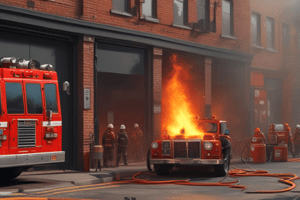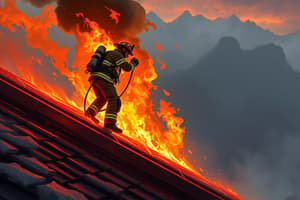Podcast
Questions and Answers
What is the primary consideration when deciding between a defensive or offensive attack strategy?
What is the primary consideration when deciding between a defensive or offensive attack strategy?
- Availability of water supply
- Type of foam used
- Presence of an immediate life hazard (correct)
- Weather conditions
Which of the following is NOT advised when operating in a potentially explosive environment?
Which of the following is NOT advised when operating in a potentially explosive environment?
- Seal off storm drain openings
- Post responders in IDLH zones (correct)
- Use indirect area monitoring
- Monitor areas from the side
What should be done immediately if a flammable product has entered storm drains?
What should be done immediately if a flammable product has entered storm drains?
- Block all storm drains with foam
- Contact appropriate agencies for mitigation (correct)
- Evacuate everyone from the area
- Begin an offensive attack
When applying foam during a fire attack, which is the correct approach?
When applying foam during a fire attack, which is the correct approach?
Which action should be taken for public safety during an incident involving flammable vapors?
Which action should be taken for public safety during an incident involving flammable vapors?
In the context of incident mitigation, what does 'diking' refer to?
In the context of incident mitigation, what does 'diking' refer to?
What information should be communicated to Metro during a hazardous incident?
What information should be communicated to Metro during a hazardous incident?
What is an essential factor in ensuring a secure water supply for fire operations?
What is an essential factor in ensuring a secure water supply for fire operations?
What is the primary goal of implementing a defensive attack during a fire incident?
What is the primary goal of implementing a defensive attack during a fire incident?
When should foam be reapplied during a fire incident?
When should foam be reapplied during a fire incident?
What is a critical safety consideration during an incident involving an overturned gasoline truck?
What is a critical safety consideration during an incident involving an overturned gasoline truck?
What should be done to control environmental damage during a defensive attack?
What should be done to control environmental damage during a defensive attack?
Which statement best describes the behavior of gasoline when it is burning?
Which statement best describes the behavior of gasoline when it is burning?
In which situation is an offensive attack typically NOT employed?
In which situation is an offensive attack typically NOT employed?
What is a potential consequence of an overturned gasoline tank truck related to size and weight?
What is a potential consequence of an overturned gasoline tank truck related to size and weight?
What is NOT a primary consideration for incident responders during an overturned gasoline truck situation?
What is NOT a primary consideration for incident responders during an overturned gasoline truck situation?
Which of the following is a primary focus in the RECEO fire extinguishment strategy?
Which of the following is a primary focus in the RECEO fire extinguishment strategy?
When is foam application considered appropriate during fire operations?
When is foam application considered appropriate during fire operations?
What is a critical safety protocol for handling flammable materials during an incident?
What is a critical safety protocol for handling flammable materials during an incident?
What is the role of foam tender resources in fire incidents?
What is the role of foam tender resources in fire incidents?
Which strategy focuses on protecting the public and controlling fire spread during an incident?
Which strategy focuses on protecting the public and controlling fire spread during an incident?
What should be ensured regarding access routes for incoming resources during a hazardous incident?
What should be ensured regarding access routes for incoming resources during a hazardous incident?
What resources should be coordinated during an incident involving hazardous materials?
What resources should be coordinated during an incident involving hazardous materials?
Which of the following agencies is responsible for traffic control on city streets during incidents?
Which of the following agencies is responsible for traffic control on city streets during incidents?
Flashcards are hidden until you start studying
Study Notes
Water Supply and Fire Attack Strategies
- Secure adequate water supply for multiple master stream operations; avoid using plain water except for rescue tasks.
- Utilize foam lines to combat fire effectively; consider the use of dikes to prevent spilled or burning products from entering storm drains.
- Incident Commander assesses whether to deploy a defensive, offensive, or combined attack based on incident specifics.
Gasoline Spill Mitigation
- Initial defensive measures, such as diking, may not suffice if gasoline enters storm drains.
- Contact relevant agencies for aid if the product infiltrates subterranean areas (vaults, storm drains, sewer systems).
- Monitor areas for explosive risks and flammable vapors:
- Conduct indirect area monitoring to keep responders out of IDLH (Immediately Dangerous to Life or Health) zones.
- Position monitoring safely away from openings or covers to gauge vapor presence.
- Limit public access to hazardous areas.
HMTF's and Public Notifications
- Hazardous Materials Task Forces (HMTF) and squads conduct perimeter surveys and mapping for potential pipelines and flow paths.
- Notify local Metro services of public safety measures, such as shelter-in-place advisories, and communicate risks effectively to residents.
Offensive and Defensive Attacks
- Offensive attack involves immediate life hazards and ensures adequate resources are available for extinguishing fires efficiently; foam must be reapplied to sustain a protective blanket.
- Defensive attack is used when no hazards are present or resources are limited; focus shifts to protecting personnel and avoiding direct firefighting. Let the fire burn out naturally while controlling runoff.
Overturned Gasoline Tank Incidents
- Overturned gasoline trucks pose significant challenges, including stability risks and potential leaks or spills.
- Must consider rescue operations for trapped drivers and the complexity of identifying diverse products within multi-compartment tanks.
- A fully loaded gasoline truck can weigh up to 80,000 pounds and present serious risks during operations.
Response Protocol: RECEO
- RECEO principle guides recovery efforts:
- Rescue: Rapid extraction of victims and evacuation of affected areas.
- Exposures: Confinement of spilled materials with dikes and protection of storm drains.
- Extinguish: Prioritize extinguishing fires when conditions allow.
- Overhaul/off-loading operation: Manage cleanup and safe removal of hazardous materials.
Operational Considerations
- Direct incoming response resources to safe locations, avoiding routes through hazardous areas.
- Ensure water supply and foam provisions align with incident needs before deploying foam for extinguishment.
- Hazard monitoring is critical to eliminate ignition sources where possible; appropriate atmospheric monitoring tools are essential.
Resource Allocation
- LAFD and other agencies provide vital resources, including:
- Hazardous Materials Task Forces for specialized support.
- Access to heavy equipment like vacuum trucks and heavy wreckers for incident management.
- Traffic control cooperation with LAPD and CalTrans to ensure safe access for emergency responders.
Studying That Suits You
Use AI to generate personalized quizzes and flashcards to suit your learning preferences.




